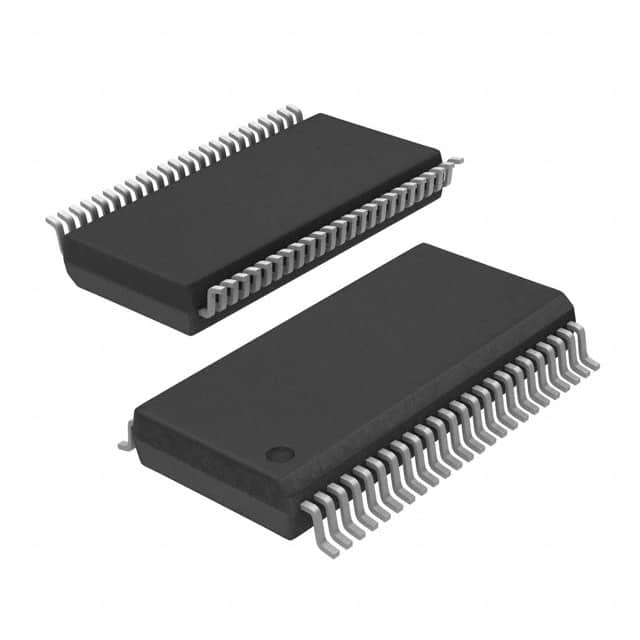CY74FCT162245TPVCT
Product Overview
- Category: Integrated Circuit (IC)
- Use: Data transmission and signal conversion
- Characteristics: High-speed, low-power, bidirectional data bus transceiver
- Package: 48-pin TSSOP (Thin Shrink Small Outline Package)
- Essence: Transceiver IC for bidirectional data communication
- Packaging/Quantity: Tape and reel packaging, 2500 units per reel
Specifications
- Supply Voltage: 4.5V to 5.5V
- Input/Output Voltage Range: 0V to VCC
- Operating Temperature Range: -40°C to +85°C
- Maximum Data Rate: 200MHz
- Number of Channels: 16
- Logic Family: FCT (Fast CMOS TTL)
Detailed Pin Configuration
The CY74FCT162245TPVCT has a total of 48 pins, which are divided into various functional groups:
- VCC - Power supply voltage
- GND - Ground reference
- OE\ - Output Enable input
- DIR - Direction control input
- A1-A8 - Data bus inputs/output group A
- B1-B8 - Data bus inputs/output group B
(Note: The pin numbers mentioned above are just for representation purposes and may vary in the actual package.)
Functional Features
- Bidirectional data transmission: Allows data to be transmitted in both directions on the same bus.
- High-speed operation: Supports data rates up to 200MHz, enabling fast data transfer.
- Low power consumption: Designed with low-power CMOS technology, minimizing energy usage.
- Output enable control: The OE\ pin allows the user to enable or disable the outputs as needed.
- Direction control: The DIR pin determines the direction of data flow on the bus.
Advantages and Disadvantages
Advantages: - High-speed operation enables efficient data transfer. - Low power consumption reduces energy usage. - Bidirectional communication simplifies system design. - Compact package size saves board space.
Disadvantages: - Limited number of channels (16) may not be suitable for applications requiring a higher channel count. - Operating temperature range (-40°C to +85°C) may not be suitable for extreme environments.
Working Principles
The CY74FCT162245TPVCT is based on Fast CMOS TTL logic, which allows for high-speed data transmission. It operates by receiving input data from one bus and transmitting it to the other bus in the opposite direction. The direction of data flow is controlled by the DIR pin. The OE\ pin enables or disables the outputs, allowing the user to control when data is transmitted.
Detailed Application Field Plans
The CY74FCT162245TPVCT is commonly used in various applications, including:
- Data communication systems: Used for bidirectional data transmission between different subsystems or devices.
- Memory interfacing: Facilitates data transfer between microcontrollers and memory modules.
- Industrial automation: Enables communication between different components in automated systems.
- Networking equipment: Used in routers, switches, and network interface cards for data transmission.
- Test and measurement instruments: Allows for high-speed data acquisition and signal conversion.
Detailed and Complete Alternative Models
- SN74FCT162245T - Similar bidirectional transceiver IC from Texas Instruments.
- MC74FCT16245 - Another alternative from ON Semiconductor with similar functionality.
- 74FCT162245AT - Bidirectional transceiver IC from Fairchild Semiconductor.
(Note: The above list is not exhaustive and there may be other alternative models available in the market.)
In conclusion, the CY74FCT162245TPVCT is a high-speed, low-power bidirectional data bus transceiver IC. It offers advantages such as efficient data transfer, low power consumption, and compact package size. However, it has limitations in terms of the number of channels and operating temperature range. It finds applications in various fields including data communication systems, memory interfacing, industrial automation, networking equipment, and test and measurement instruments. Alternative models from different manufacturers are also available for consideration.
قم بإدراج 10 أسئلة وإجابات شائعة تتعلق بتطبيق CY74FCT162245TPVCT في الحلول التقنية
Sure! Here are 10 common questions and answers related to the application of CY74FCT162245TPVCT in technical solutions:
Q: What is CY74FCT162245TPVCT? A: CY74FCT162245TPVCT is a 16-bit bus transceiver with 3-state outputs, designed for high-speed CMOS applications.
Q: What is the voltage range supported by CY74FCT162245TPVCT? A: CY74FCT162245TPVCT supports a voltage range of 4.5V to 5.5V.
Q: What is the maximum data transfer rate of CY74FCT162245TPVCT? A: The maximum data transfer rate of CY74FCT162245TPVCT is typically 250MHz.
Q: Can CY74FCT162245TPVCT be used for bidirectional data communication? A: Yes, CY74FCT162245TPVCT can be used for bidirectional data communication as it has separate input and output pins.
Q: How many channels does CY74FCT162245TPVCT have? A: CY74FCT162245TPVCT has 16 channels, allowing for the transmission of 16 bits of data simultaneously.
Q: What is the power supply current required by CY74FCT162245TPVCT? A: The power supply current required by CY74FCT162245TPVCT is typically around 50mA.
Q: Can CY74FCT162245TPVCT handle level shifting between different voltage domains? A: Yes, CY74FCT162245TPVCT can handle level shifting between different voltage domains, making it suitable for interfacing between different logic families.
Q: Does CY74FCT162245TPVCT have built-in ESD protection? A: Yes, CY74FCT162245TPVCT has built-in ESD protection, ensuring robustness against electrostatic discharge events.
Q: What is the operating temperature range of CY74FCT162245TPVCT? A: CY74FCT162245TPVCT can operate within a temperature range of -40°C to 85°C.
Q: Can CY74FCT162245TPVCT be used in high-speed data communication applications? A: Yes, CY74FCT162245TPVCT is suitable for high-speed data communication applications due to its fast switching speed and low propagation delay.
Please note that these answers are general and may vary depending on the specific datasheet and application requirements.


